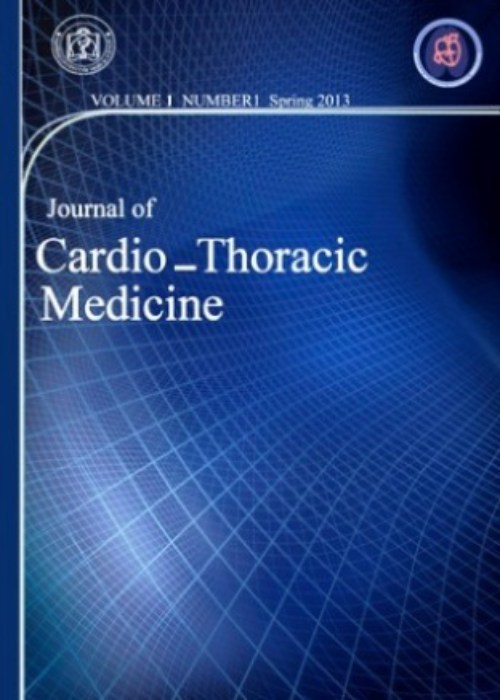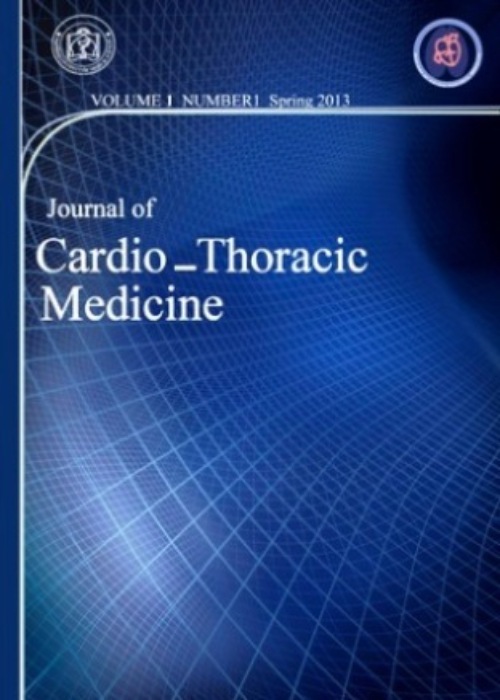فهرست مطالب

Journal of Cardio -Thoracic Medicine
Volume:10 Issue: 4, Autumn 2022
- تاریخ انتشار: 1401/10/26
- تعداد عناوین: 7
-
-
Pages 1052-1064IntroductionFor interpretation of the most common biochemical markers reference intervals (RIs) are widely considered and reported. Therefore, in this study, we aimed to determine age-specific RIs for some biochemical tests by removing and/or limiting critical gaps including sex, age group, geographical region, measurement device, and type of kits and reagents for routine laboratory biochemical variables in healthy adolescent girls aged 12-19 years.Materials and MethodsIn this cross-sectional study a total of 1026 adolescent girl was recruited. According to the study aim, the levels of serum for some routine biochemical tests were measured on a BT-3000 auto-analyzer. On the basis of the non-parametric rank method and by use of CLSI Ep28-A3 guidelines, we determined age-specific RIs, including confidence interval 90%, under specific exclusion criteria.ResultsAge partitioning was required for none of the upper and lower limits of biochemical markers. All Serum biochemical tests concentration remained relatively constant throughout the age range.ConclusionBy removing and/or limiting critical gaps involved in reference values of biochemical tests, it has provided an important understanding of metabolic processes and it has facilitated clinical application to track different diseases betterKeywords: adolescent girls, Biochemical markers, CLSI guidelines, Reference intervals
-
Pages 1065-1070IntroductionLung malignancy is the main and utmost type of cancer cases and mortality with raising trends in recent decades particularly in emergent countries like India. Lung malignancy can be suspected when patient presents with clinical symptoms like cough, hemoptysis or incidental abnormality on chest x-ray/ Computed Tomography or by screening with low-dose CT.Material and MethodsA retrospective observational study done at Government hospital for chest and communicable diseases under Andhra Medical College, India from Jan 2017 to Dec 2019. Patients diagnosed with bronchogenic carcinoma either inpatient or outpatient were taken into consideration for analysis.ResultsA total of 173 subjects were considered in study for analysis. Mean age found to be 57.67±11.36 years. 121 patients were male and 52 were female. 69.36% patients belonged to rural areas. 82.08% which accounted for 142 patients were smokers. Mean smoking index was 258±246.63. Most common presentation was cough and sob i.e., 83.24%. Most common radiological presentation was mass i.e., 54.3% (94) followed by pleural effusion in 24 cases (13.8%). Adenocarcinoma was observed in 83 patients (48%) followed by squamous cell in 61 patients (35%).ConclusionLung cancer was more common in elderly subjects with age >50 years with mean age of presentation in females being lower than males. Adenocarcinoma was the predominant histological type in both males and females. Smoking still continues to be the main and important risk factor for lung cancer.Keywords: Smoking, Adenocarcinoma, Mass, Squamous cell carcinoma
-
Pages 1071-1077IntroductionThe on-pump beating heart technique for myocardial revascularization with a normothermic Cardiopulmonary bypass (CPB) represents a combination of standard on-pump and off-pump bypass techniques. The purpose of our study was to evaluate the outcome of patients with acute coronary syndrome undergoing on-pump beating coronary artery bypass grafting (CABG).MethodsBetween February 2020 and February 2021, 125 consecutive patients with acute coronary syndrome requiring coronary revascularization and not candidate for primary angioplasty or thrombolytic therapy, underwent on-pump beating myocardial revascularization. In this cohort study the primary inclusion criteria were the persistence of coronary artery disease (CAD) suitable for CABG and acute coronary syndrome. Our outcome variables included all-cause mortality, low cardiac output state, arrhythmia, postoperative myocardial infarction (MI), respiratory failure, stroke, ICU and total hospital stay.ResultsMean age of patients was 59.11±9.81 years (range 33–84 years) and 68% of patients were male. Preoperative mean left ventricular ejection fraction was 43.61 ± 9.61 % (range 10-60 %) which improved to 46.71±8.41% postoperatively (p=0.010). The average number of graft per patient was 2.91±0.71 and complete revascularization was performed in 119 patients (95.2%). Mean ICU stay of patients was 2.11±1.41 (range 1–12) and mean hospital stay of patients was 6.11 ± 3.71 (range 5–15). Three patients (2.4%) died during recovery in the ICU due to acute cardiac failure.ConclusionOn-pump beating CABG (OPBCABG) is an effective strategy with improved hospital outcome and can be a good alternative to conventional CABG and off-pump cardiac bypass surgery in acute coronary syndrome (ACS).Keywords: Coronary artery bypass grafting, Myocardial Revascularization, Acute coronary syndrome
-
Pages 1078-1088IntroductionIn addition to the well-known benefits of cardiopulmonary bypass (CPB), there are also certain possible risks, some of which are avoidable and some of which are accidental. In addition to CPB, potentially life-threatening consequences include human error and mechanical disruptions. The purpose of this study is to conduct a retrospective analysis of CPB accidents in Iranian cardiovascular surgery departments.MethodsThis study included 151 Iranian perfusionists who were evaluated using a questionnaire created by the researchers. The questionnaire recorded all participants' demographic information as well as their experiences with human errors (e.g., perfusionist fatigue and drowsiness; errors in CPB circuit arrangement; and so on) and mechanical disturbances (cooling-warming circuit, oxygenator failure, electrical disruption, and so on). SPSS Version 16 was used to analyze all of the data.Result1) venous obstruction and improper venous return had the highest recurrence rate of 89.4%, 2) Removing the venous cannula and venting the venous path 86.8%, 3) 79.5% were unable to raise (ACT) more than 400. Most significant injuries were caused by clots or thrombi during CPB (2.6%), 2) failure of the oxygenator (2.6%). Most deaths were caused by an air embolism (5.29).ConclusionsAlthough the occurrence of human errors and mechanical disturbances cannot be predicted, they can be mitigated by the sharing of accidents and mistakes.Keywords: Cardiopulmonary machine, Human errors, Mechanical disturbances, cardiopulmonary accidents
-
Pages 1089-1093
A new infection emerged into the world which has been declared a global pandemic in December 2019, termed SARS-CoV-2 based on its first pulmonary manifestations. Also, Neurologic consequences can be disturbing complications of these respiratory viral diseases.Here we present a 51-year-old nurse with motor-sensory symptoms following developed mild coryza symptoms including sore throat, general malaise, and conjunctivitis. However, a week of ocular muscle discomfort and weakness preceded coryza symptoms. She was returned negative by nasopharyngeal swab test twice for detection of the SARS-Cov-2 genome by a real-time polymerase chain reaction (PCR) and Chest X-Ray (CXR) examination. Since the patient had neurological symptoms, MRI was performed, which showed inflammation in the spinal cord and meninges.Cerebrospinal fluid (CSF) fluid investigation for immunological and Covid-19 examination showed SARS-Cov-2 involvement in this patient. The patient's characteristics show that the involvement of Covid-19 is not limited to the lungs or gastrointestinal tract, and the nervous system, despite the presence of a brain barrier, can be invaded by the virus. From this point of view, we should expect a shadow of the involvement of different parts of the nervous system in Covid-19.
Keywords: CSF fluid, Neurologic, SARS-Coronavirus-2 -
Pages 1094-1098
Tuberculosis (TB) is still a significant medical and social problem in developing nations like Indonesia, with high morbidity and mortality rates. Tuberculosis infection are mostly found in the lungs, but they can affect other organs as well. Secondary spontaneous pneumothorax (SSP) is one of the most serious complications of tuberculosis, requiring the insertion of a chest tube in the majority of cases. The Heimlich valve can be used in complicated and persistent pneumothorax. The Heimlich valve may be outdated, but it is a very efficient one-way valve that provides safe air evacuation from the thoracic cavity. A 53-year-old man was hospitalized after complaining of left-sided chest discomfort and shortness of breath. The patient confirmed receiving tuberculosis treatment four years ago. During a physical examination, hyperresonance to percussion and decreased vesicular breath sounds was found on left side, wheezing on the right, and SaO2 of 92% in room air. An x-ray of the chest revealed a left side pneumothorax and fibrosis at the right lung's apex. Emergency drainage was done and an X-ray evaluation of the collapsed lung aeration was observed. However, even though drainage has been done for 19 days, an examination revealed persistent pneumothorax, requiring extended drainage. Due to a lack of resources and to prevent prolonged hospitalization, we began using a Heimlich valve to treat pneumothorax. The chest tube and Heimlich valve were detached successfully after two months. In conclusion, the Heimlich valve provides a practical and affordable treatment for ambulatory care of persistent pneumothorax.
Keywords: Heimlich valve, Persistent pneumothorax, pulmonary tuberculosis -
Pages 1099-1101
Uterine neoplasm metastases to heart is infrequent, especially from uterine cancer, although it is possible because leiomyosarcoma is very invasive. We present a case of a 33 years old woman with 9 months evolution of this neoplasm. By cardiac and brain symptomatology, this patient was diagnosed with cardiac and brain tumors in imaging studies. The patient underwent tumors resection by cardiac surgery and stereotaxic procedure and subsequent chemo and radiotherapy, without neurological and cardiac symptoms in her evolution.
Keywords: Cardiac Metastasis, Leiomyosarcoma, Uterine neoplasms


